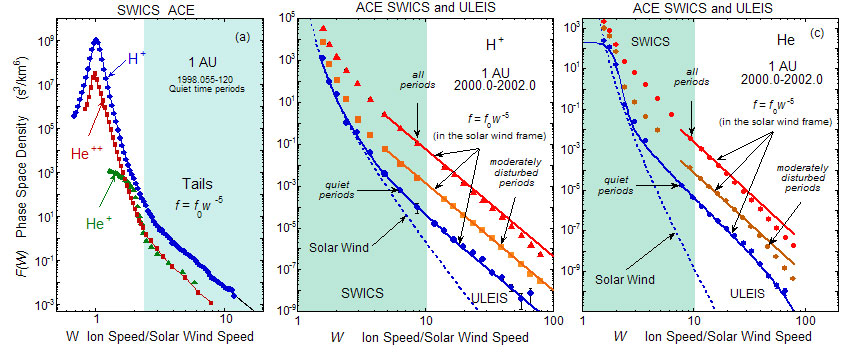
| ACE News Archives | ACE News #98 - June 30, 2006 |
Subscribe to ACE News |

Suprathermal tails on the velocity distributions of solar wind and pickup ions, commonly observed downstream of shocks in the heated solar wind, were generally believed to be particles accelerated by these shocks from their parent distributions. Many shock acceleration mechanisms, however, needed some minimum "injection energy" that was several times larger than the typical solar wind or even pickup ion energy, requiring some pre-acceleration. Measurements with the Solar Wind Ion Composition Spectrometers (SWICS) on ACE and Ulysses revealed that suprathermal tails were common not only behind shocks but also in the most quiet solar wind far away from shocks. These suprathermal quiet-time tails, shown in the left-hand panel above, were found to have a common spectral shape, a power law with spectral index of -5 in the solar wind frame of reference. (These plots show the phase space density, defined as the density of particles in a unit volume of velocity space, as a function of particle speed.) Whether or not these suprathermal tails extended far enough in energy to be above the injection energy threshold for efficient shock acceleration could not be determined using the SWICS measurements alone, since these extend only to ~ 100 keV/charge.
To answer this question we combined SWICS with ULEIS proton and He spectra from ACE as shown in the middle and right-hand panels. During quiet time periods the -5 power-law tail distribution for H extends all the way to the upper energy range of ULEIS (a few MeV) with no obvious rollover. During moderately disturbed times, and when all the data during the two year period were averaged, the tail spectra are still -5 power laws, but now both the rollover and the onset of the power-law portion of the tail move to lower speeds, and the phase space density in the tails increases with increasing levels of turbulence. The helium spectra are also power laws with index -5, but their rollover speed is lower than that for protons, and decreases with increasing levels of solar wind turbulence. These ACE results tell us that pre-accelerated solar wind and pickup ions are ubiquitous in the solar wind and thus are the natural source of particles that are further accelerated to higher energies by shocks.
Fisk and Gloeckler (ApJ. 640, L79-L82, 2006) have shown recently that these ubiquitous power-law tails with the unique spectral index of -5 can be produced by stochastic acceleration due to compressional turbulence in the solar wind, in which the particles are accelerated by and do an equal amount of work on the turbulence. The unique -5 spectrum that is observed is formed by a cascade in energy, analogous to Kolmogorov's turbulent cascades.
Contributed by George Gloeckler and Len Fisk, University of Michigan, and Glenn Mason, JHU/Applied Physics Laboratory. Please direct questions or comments to George Gloeckler at
Last modified 30 Jun 2006, by